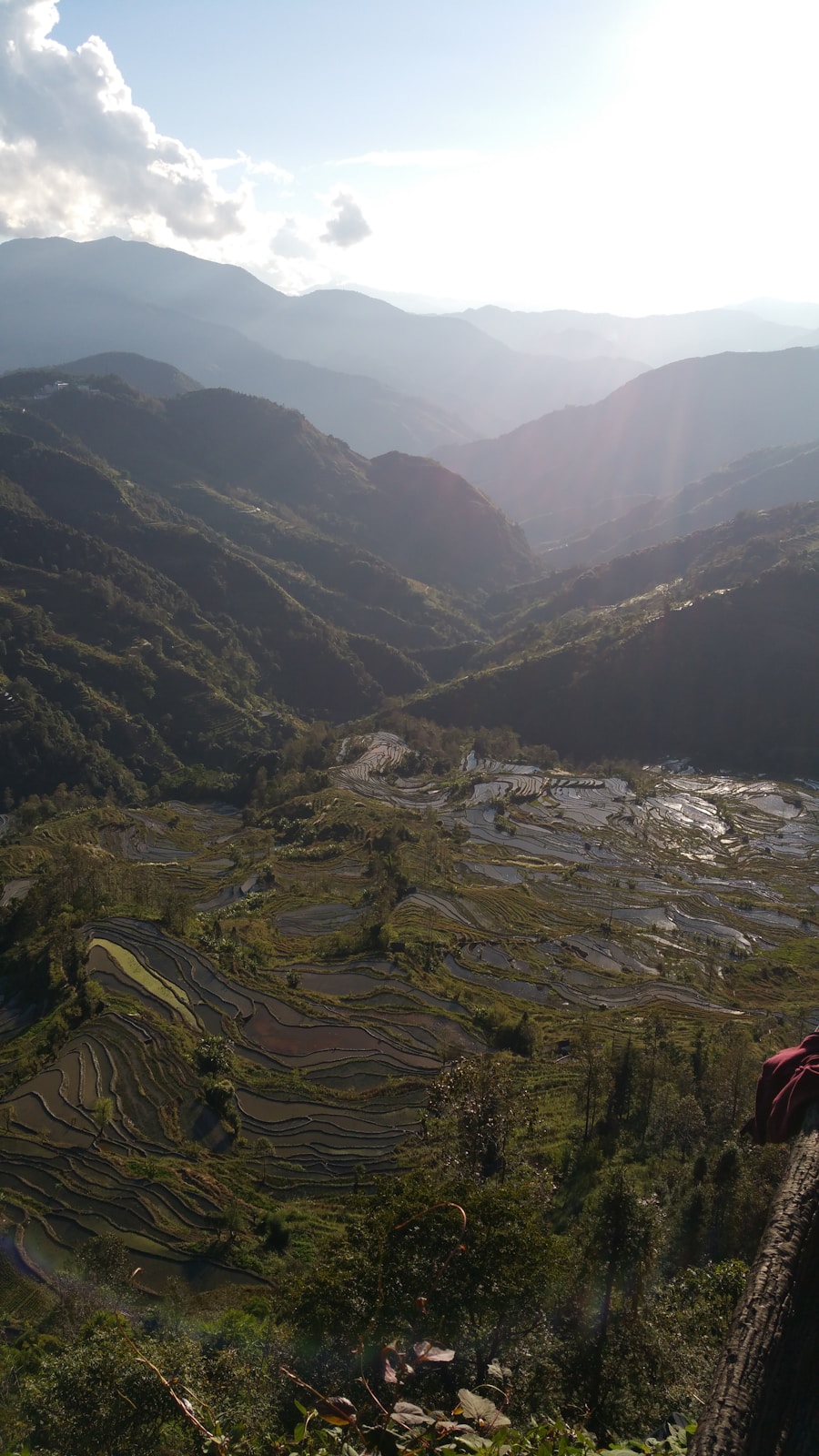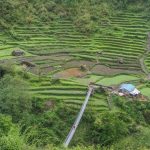Preserving the Banaue Rice Terraces: A Cultural Heritage
Description
The Banaue Rice Terraces, often referred to as the “Eighth Wonder of the World,” are a remarkable feat of engineering and agriculture that date back over 2,000 years.
The construction of these terraces is believed to have begun around 2000 B.C., showcasing the ingenuity and resilience of the Ifugao culture.
The terraces are not merely agricultural fields; they represent a deep connection between the Ifugao people and their land, embodying centuries of tradition, knowledge, and sustainable farming practices. The terraces stretch over 2,000 square kilometers and rise to an elevation of approximately 1,500 meters above sea level. Each terrace is meticulously constructed with stone walls and is designed to capture and retain water from the surrounding mountains, allowing for efficient irrigation.
The Ifugao people developed a unique system of rice cultivation that includes various rice varieties suited to different altitudes and microclimates. This agricultural system is not only a testament to their engineering skills but also reflects their understanding of ecological balance and sustainability. The terraces have been recognized as a UNESCO World Heritage Site since 1995, highlighting their cultural significance and the need for their preservation.
Key Takeaways
- The Banaue Rice Terraces were built over 2,000 years ago by the Ifugao people without the use of modern tools, and are often referred to as the “Eighth Wonder of the World.”
- Preserving the Banaue Rice Terraces is crucial for maintaining the cultural heritage of the Ifugao people and for sustaining the local ecosystem, as they are a source of irrigation and biodiversity.
- The Banaue Rice Terraces face threats such as soil erosion, climate change, and the migration of younger generations away from traditional farming practices.
- Efforts to preserve the Banaue Rice Terraces include the implementation of sustainable farming practices, the construction of irrigation systems, and the promotion of eco-tourism to generate income for the local community.
- The Banaue Rice Terraces hold immense cultural significance for the Ifugao people, serving as a symbol of their connection to the land and their ancestors, and are recognized as a UNESCO World Heritage Site.
- Ways to support the preservation of the Banaue Rice Terraces include visiting the terraces as a responsible tourist, supporting local initiatives and businesses, and spreading awareness about their cultural and environmental importance.
The Importance of Preserving the Banaue Rice Terraces
Preserving the Banaue Rice Terraces is crucial for several reasons, including cultural heritage, environmental sustainability, and economic stability for local communities. The terraces are a living testament to the agricultural practices and traditions of the Ifugao people, representing a unique cultural identity that has been passed down through generations. As globalization and modernization continue to influence rural communities, there is a growing risk that traditional practices may be lost.
By preserving the rice terraces, we not only safeguard the agricultural techniques that have sustained the Ifugao people for centuries but also protect their cultural narratives and identity. Moreover, the terraces play a vital role in maintaining biodiversity and ecological balance in the region. The intricate irrigation systems and diverse rice varieties cultivated in the terraces contribute to a rich ecosystem that supports various plant and animal species.
The preservation of these terraces helps maintain soil health, prevents erosion, and promotes sustainable land use practices. In an era where climate change poses significant threats to agriculture worldwide, the traditional farming methods employed by the Ifugao people offer valuable insights into sustainable practices that can be adapted in other regions facing similar challenges.
Threats to the Banaue Rice Terraces

Despite their historical and cultural significance, the Banaue Rice Terraces face numerous threats that jeopardize their existence. One of the most pressing issues is the impact of modernization and urbanization. As younger generations migrate to urban areas in search of better economic opportunities, traditional farming practices are being abandoned.
This shift not only leads to a decline in rice production but also results in the deterioration of the terraces themselves. Without regular maintenance and cultivation, the stone walls that hold the terraces together begin to crumble, leading to soil erosion and loss of agricultural land. Additionally, climate change poses a significant threat to the rice terraces.
Changes in weather patterns, such as increased rainfall intensity and prolonged droughts, can disrupt the delicate balance of water management that is essential for terrace farming. The Ifugao people have historically relied on traditional knowledge to adapt to environmental changes; however, the rapid pace of climate change presents challenges that may exceed their adaptive capacity. Furthermore, natural disasters such as landslides and typhoons can cause immediate damage to the terraces, further exacerbating their vulnerability.
Efforts to Preserve the Banaue Rice Terraces
| Efforts | Metrics |
|---|---|
| Number of terraces preserved | 2,000 |
| Area covered by preservation efforts | 10,360 hectares |
| Investment in preservation projects | 5 million |
| Number of local farmers involved | 500 |
In response to these threats, various efforts have been initiated to preserve the Banaue Rice Terraces and support the Ifugao community. Local government units, non-governmental organizations (NGOs), and international agencies have collaborated on projects aimed at restoring and maintaining the terraces. These initiatives often involve training programs for local farmers that focus on sustainable agricultural practices, soil conservation techniques, and effective water management strategies.
By empowering local communities with knowledge and resources, these efforts aim to revitalize traditional farming practices while ensuring that younger generations remain engaged in terrace cultivation. One notable initiative is the “Ifugao Rice Terraces Rehabilitation Project,” which seeks to restore damaged terraces and promote sustainable rice production. This project emphasizes community participation and aims to create alternative livelihood opportunities for farmers who may be struggling due to declining rice yields.
By diversifying income sources through eco-tourism and handicrafts, local communities can reduce their reliance on traditional rice farming while still preserving their cultural heritage. Additionally, educational campaigns aimed at raising awareness about the importance of the rice terraces have been implemented to garner support from both local residents and international visitors.
The Cultural Significance of the Banaue Rice Terraces
The cultural significance of the Banaue Rice Terraces extends far beyond their agricultural value; they are deeply intertwined with the spiritual beliefs and social practices of the Ifugao people. The terraces are not merely fields; they are sacred landscapes that embody ancestral wisdom and cultural identity. Traditional rituals and ceremonies are often conducted in connection with rice planting and harvesting, reflecting a profound respect for nature and its cycles.
These practices reinforce community bonds and foster a sense of belonging among the Ifugao people. Furthermore, the rice terraces serve as a symbol of resilience and adaptability in the face of adversity. The Ifugao people’s ability to cultivate rice in such challenging terrain speaks volumes about their ingenuity and determination.
This cultural narrative is essential for instilling pride among younger generations, encouraging them to embrace their heritage while navigating modern challenges. The terraces also attract tourists from around the world, providing an opportunity for cultural exchange and education about indigenous practices. This interaction can foster greater appreciation for traditional knowledge systems and promote sustainable tourism practices that benefit local communities.
Ways to Support the Preservation of the Banaue Rice Terraces

Responsible Tourism
One effective way individuals can contribute is by visiting the terraces as responsible tourists. By choosing eco-friendly accommodations and participating in community-led tours, visitors can directly support local economies while promoting sustainable tourism practices.
Community Engagement and Financial Support
Engaging with local farmers and learning about their traditional agricultural methods can foster a deeper understanding of their culture and challenges. Additionally, financial contributions to organizations dedicated to preserving the rice terraces can make a significant impact.
Advocacy and Cultural Heritage
Supporting local artisans who produce handicrafts or traditional textiles can also provide alternative income sources for families who may be struggling due to declining rice yields. Advocacy plays a crucial role in raising awareness about the importance of preserving the Banaue Rice Terraces on a global scale. By amplifying the voices of the Ifugao people and promoting their stories, we can contribute to a collective effort aimed at safeguarding this invaluable cultural heritage for future generations.
FAQs
What are the Banaue Rice Terraces?
The Banaue Rice Terraces are ancient terraces carved into the mountains of Ifugao in the Philippines. They are often referred to as the “Eighth Wonder of the World” and are a UNESCO World Heritage Site.
How were the Banaue Rice Terraces created?
The terraces were hand-carved over 2,000 years ago by the Ifugao people using minimal equipment, mostly by hand. They were created to make the mountainous terrain suitable for rice cultivation.
What is the significance of the Banaue Rice Terraces?
The terraces are not only a stunning example of ancient engineering and agricultural practices, but they also hold cultural and historical significance for the Ifugao people. They are a symbol of their heritage and connection to the land.
Can visitors explore the Banaue Rice Terraces?
Yes, visitors can explore the terraces and even hike through them. There are designated viewpoints and trails for tourists to experience the beauty and grandeur of the terraces.
What is the current state of the Banaue Rice Terraces?
The terraces are facing challenges such as erosion, lack of maintenance, and the migration of younger generations away from traditional farming practices. Efforts are being made to preserve and protect the terraces for future generations.





